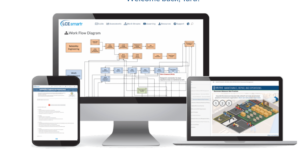International standards define reliability as the probability that a unit will perform its required functions, without failure for a specified time period when used under specified conditions. (1)
The reliability of an asset is set in the design phase of that unit’s life. Of course, the production phase can introduce changes to the design reliability, normally reducing it. This is the delivered reliability. Then the asset must be installed, introducing the uncertainties of quality of workmanship and oversight. After installation, the power is applied and the asset is activated and operated, creating even more uncertainty as to the actual reliability on the shop floor. When the asset has a problem, the thoroughness and quality of the maintenance performed to restore it to its original state can also vary. All of these elements affect the achieved reliability of an asset.
To a large extent, the achieved reliability of an asset is controllable first, by the manufacturer (OEM), and then by the owner/end user. When an asset is manufactured, Reliability Engineers participate in design efforts to guide the reliability (and maintainability) of new products. During production, the Reliability Engineers monitor the prototype and production testing, which they had a hand in designing, to monitor the delivered reliability.
At installation, world-class companies routinely assign Reliability Engineers to the construction/installation team to help ensure that the asset is put into an operational status in the proper condition. Reliability Engineers also work with the design team to develop the asset’s maintenance program. This would include a bill of materials (BOM), operator maintenance plans, and the preventive and predictive maintenance guidelines that are passed on to the owner at commissioning.
Reliability Engineers at the owner/end-user organization also play an important role. In a world-class operation, Reliability Engineers accept the data input from the OEM. This information is installed into the end user’s data files and provides the basis for the asset hierarchy, asset maintenance plan, initial spares procurement and required training.
The end user Reliability Engineers will have had a part in the procurement of the new asset from the original requirement for that asset. Typically, Reliability Engineers are generalists. Part of their function is to provide the purchasing department with the “soft” requirements for new assets. These requirements include ensuring that the proper data is required that allows building the asset bill of materials and provides the necessary information for any predictive maintenance program envisioned for the asset. The requirements also will address the allowable unbalance in rotating equipment, allowable vibration levels, degree of alignment on coupled machines and quite possibly the lubricant to be used in common items such as motors, gearboxes, etc. The end user Reliability Engineers will also play a large part in the commissioning process, including verification of all of the “soft” requirements prior to acceptance.
This is all well and good if you are in a world-class operation. But what if you are trying to get to world-class and need to justify an investment in reliability engineering? How can you show that a reliability engineer adds value? Here are some of the ways a Reliability Engineer can improve your achieved asset reliability, saving your organization time and money. (Keep in mind that increasing asset utilization by only 1% can drive measurable bottom-line improvement.)
Think Outside the Box
Tangible benefits come from thinking outside of the usual comfort zone of the organization. Poor practices become ingrained and lead to “we’ve always done it that way” attitudes. An example is the expected service life of the equipment. Buying purely on cost is seldom a good practice for equipment. In one meat plant, buying totally enclosed fan-cooled (TEFC) motors were the norm as they cost less than wash-down rated motors. Of course, the area required a daily wash-down. Convincing management that three to six months of service life was not the norm – and that the plant could do better — allowed a trial purchase of wash-down rated motors. Changing to wash-down-rated motors increased the unit cost by approximately 20 percent. Many of those motors have exceeded 10 years of service to date.
Re-examine Shutdown Practices
During an annual shutdown, I watched a crew change belts on a critical air handler. I watched as the 5 D-size belts were rolled on over a bar. I asked the obvious question of why that was being done. “You have to pre-stretch the belts or come back later and re-tension them,” I was told. Taking this information up to our HVAC lead, I asked him where this information had come from. He informed me that he had been taught the trade by his father who was a master mechanic. While I did not doubt his explanation or his father’s skills, I asked when his father had done his apprenticeship. His father had been one of the very early HVAC specialists in the area and was trained before v-belts were strengthened with cording. Our belting vendor was brought in for a training session where myths about belts were discussed. Following that session, we changed our maintenance instructions to require loosening the motor, properly installing the belts and then setting the tension. Of course, this added about 15 percent more time to accomplish than the original, so how did this change affect reliability? By not damaging the belts during the installation, we changed the task from an annual one to a tri-annual one.
Check the Air Filter System
Many facilities have stringent requirements for the quality and quantity of the inside air. Traditionally this air quality required changing filters on a strict time basis to keep from overloading and possibly tearing the filter media. But most of these facilities also keep track of the differential pressure across the filter banks. Using readily available information on the loading and potential weakening of a filter bank allows the filters to be changed on a condition basis rather than strictly time. As an offshoot, many facilities find that the change interval is lengthened on the side of the building that is on the upwind side of normally prevailing winds. This also increased the achieved life of some filter elements, decreasing the total cost of ownership.
Check the Effectiveness of Maintenance Tasks
Reliability Engineers can also help reduce overtime. Many of the maintenance tasks that a workforce accomplishes are of dubious value. In one case an analysis of existing preventive maintenance tasks found that fully 40 percent had no value or did not address valid failure modes for the system. Removing these tasks from the schedule freed up time to accomplish not only the PM program but also more time to accomplish corrective tasks without the fire-fighting that normally occurred. At a research facility, this was especially evident when the annual shutdown of a building started on Saturday morning at 6:00 AM and went until 6:00 PM that day, started up again at 6:00 AM on Sunday and was normally completed by 4:00 PM. The first eight hours on Saturday were time and a half; the last four were double time. Sunday was double time and a half. The entire maintenance staff was required to be on board for this evolution. The following year, after an analysis of the shutdown maintenance requirements, the shutdown started at 4:00 AM for fire system (statutory) cleaning. The bulk of the maintenance force started at 7:00 AM and the job was done by 4:00 PM that day. Not only were there no adverse events from this work, but there was also a marked reduction in trouble calls on overhauled equipment in the two weeks following the evolution.
Use Predictive Technologies to Find and Correct Energy Losses
One benefit of reliability engineering that is often overlooked is the potential to lower energy costs in a plant. Using predictive technologies allows plant personnel to find energy losses and correct them. These savings are over and above the “green initiative” savings through such items as lights, improved insulation, etc. One plant used airborne ultrasound to document air leaks that cost – electricity only – $33,000 annually. Additionally, one large air compressor was taken offline with a corresponding decrease in parts and labor.
Another plant used infrared to map an oven that was in need of repair or replacement but was not in the budget cycle. The detailed scans coupled with thermal calculations showed the oven was only 6% efficient. The visual proof convinced corporate to invest in a new oven that is showing over 96% thermal efficiency. The decrease in natural gas usage has shortened the payback period significantly. Additional energy savings can come from using premium electric motors in the plant. For example, a 200 HP premium efficiency NEMA TEFC motor with electricity costs of $0.06 per kilowatt hour, will save more than $2100 per year. It is not hard to see long-term savings by using this type of motor; this should be factored into any repair or replace program for motors.
In addition to the benefits of the reliability engineering activities mentioned above, keep in mind that there are many additional benefits that may be hard to measure but are nevertheless important to the organization. These include:
Correlation between increased reliability and safety: Numerous studies have shown that plants with high reliability and excellent maintenance programs have a lower safety incident rate than those without such programs. It stands to reason that if operations are carried out in an efficient manner, there is less haste to complete actions and less risk of injury by carelessness.
Correlation between reliability and quality: It stands to reason that a process or batch line that runs without interruption is more likely to produce a consistent product than one that is subject to starts and stops during the production cycle.
Control of spare parts: With an accurate asset hierarchy and bill of materials, it is easier to carry the right quantities of parts. Couple this with an accurate CMMS and economic order quantities can be fine-tuned. Along with parts, a Reliability Engineer will scrub the lubricant list of a plant and look for opportunities to consolidate and standardize lubricants to decrease the total cost of ownership. This subject has also been detailed in various professional journals and can make an impact not only of carrying costs of supplies but also on energy usage and disposal costs of lubricants.
Reliability Engineers are valuable members of a manufacturing organization’s team. Through their efforts to improve the reliability of processes and equipment, they consistently increase asset availability and use resources more efficiently. While some results are easy to quantify and others not so obvious, the value goes directly to the bottom line of the corporation.
(1) ISO 13372 Condition monitoring and diagnostics of machines – Vocabulary
Ever considered a career in Reliability Engineering? Check this out.
© Life Cycle Engineering, Inc.
















